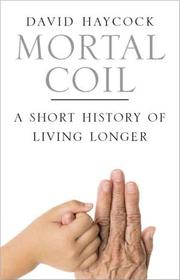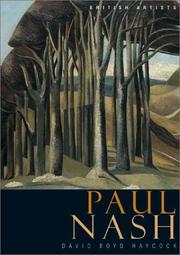| Listing 1 - 9 of 9 |
Sort by
|

ISBN: 0300117787 9780300117783 Year: 2008 Publisher: New Haven [Conn.] ; London : Yale University Press,
Abstract | Keywords | Export | Availability | Bookmark
 Loading...
Loading...Choose an application
- Reference Manager
- EndNote
- RefWorks (Direct export to RefWorks)
Aging. --- Death. --- Health Knowledge, Attitudes, Practice. --- History of medicine --- Immortality (Philosophy). --- Longevity --- Longevity. --- Medicine and society. --- Philosophy, Medical --- Public health, sanitation. --- North America. --- History.
Book
ISBN: 9781905847846 Year: 2009 Publisher: London : Old Street Publishing,
Abstract | Keywords | Export | Availability | Bookmark
 Loading...
Loading...Choose an application
- Reference Manager
- EndNote
- RefWorks (Direct export to RefWorks)
Wereldoorlog I. --- Bloomsbury Group. --- Spencer, Stanley. --- Gertler, Mark. --- Nevinson, Richard. --- Nash, Paul. --- Carrington, Dora. --- Tonks, Henry. --- Fry, Roger. --- Marsch, Eddy. --- 20ste eeuw. --- Groot-Brittannië.
Book
ISBN: 0854841016 Year: 2005 Volume: 25 Publisher: London Wellcome Trust Centre for the History of Medicine at UCL
Abstract | Keywords | Export | Availability | Bookmark
 Loading...
Loading...Choose an application
- Reference Manager
- EndNote
- RefWorks (Direct export to RefWorks)
Charlatans et charlatanisme --- Livres comptables --- Angleterre (gb) --- Londres (gb) --- 17e siecle
Multi
ISBN: 9781843835226 9781846157325 1843835223 Year: 2009 Publisher: Woodbridge The Boydell Press
Abstract | Keywords | Export | Availability | Bookmark
 Loading...
Loading...Choose an application
- Reference Manager
- EndNote
- RefWorks (Direct export to RefWorks)
History of human medicine --- History of the United Kingdom and Ireland --- anno 1700-1799 --- anno 1800-1899 --- Medicine, Naval --- History --- Great Britain. --- Medical care --- Great Britain --- Colonies

ISBN: 1854374362 Year: 2007 Publisher: Millbank, London : Tate,
Abstract | Keywords | Export | Availability | Bookmark
 Loading...
Loading...Choose an application
- Reference Manager
- EndNote
- RefWorks (Direct export to RefWorks)
Artists --- Nash, Paul,
Book
ISBN: 9781857598186 Year: 2013 Publisher: London : Scala Arts & Heritage Publishers,
Abstract | Keywords | Export | Availability | Bookmark
 Loading...
Loading...Choose an application
- Reference Manager
- EndNote
- RefWorks (Direct export to RefWorks)
Wereldoorlog I. --- Slade School of Fine Art (Londen). --- Nash, Paul. --- Nevinson, C.R.W. --- Gertler, Mark. --- Carrington, Dora. --- Bomberg, David. --- 1908 - 1922. --- 20ste eeuw.
Book
ISBN: 9781857596199 Year: 2010 Publisher: London London : Dulwich Picture Gallery Scala Publishers,
Abstract | Keywords | Export | Availability | Bookmark
 Loading...
Loading...Choose an application
- Reference Manager
- EndNote
- RefWorks (Direct export to RefWorks)
oorlogen --- Nash, Paul --- oorlogen. --- Nash, Paul.
Book
ISBN: 1282987984 9786612987984 1846157323 1843835223 Year: 2009 Publisher: Woodbridge ; Rochester, NY : Boydell Press,
Abstract | Keywords | Export | Availability | Bookmark
 Loading...
Loading...Choose an application
- Reference Manager
- EndNote
- RefWorks (Direct export to RefWorks)
Examines a wide range of aspects of health and medicine in maritime and imperial settings during the eighteenth and nineteenth century. Maritime medicine, together with its links to the development of empire, is a burgeoning area of historical interest and enquiry. This book, based on extensive original research, explores the history of health and medicine in maritime and imperial contexts in a key period, reflecting the growing professionalization of medicine at sea from the establishment of the Sick and Hurt Board to the end of the Victorian era. The chapters, written by leading expertsin the field, are grouped around two central themes: Royal Naval medical policy, administration and practice; and health and mortality relating to the migration of peoples across the globe, including slavery, emigration and indentured migration. The book will be of interest to a wide range of historians, particularly those working in the fields of maritime history, the history of medicine, and the history of colonialism and imperialism. David Boyd Haycock was Curator of Seventeenth-Century Imperial and Maritime History at the National Maritime Museum, 2007-09, and has held research fellowships at the University of Oxford, the University of California, Los Angeles and theLondon School of Economics. He is author of William Stukeley: Science, Religion and Archaeology in Eighteenth Century England, which is published by Boydell and Brewer. Sally Archer is at the National Maritime Museum. CONTRIBUTORS: Erica M. Charters, John Cardwell, Mick Crumplin, Pat Crimmin, Mark Harrison, Hamish Maxwell-Stewart, Ralph Shlomowitz, Simon J. Hogerzeil, David Richardson, Robin Haines, Laurence Brown, Radica Mahase.
Medicine, Naval --- History --- Great Britain. --- Medical care --- Great Britain --- Colonies --- Marine medicine --- Medicine, Marine --- Medicine, Nautical --- Nautical medicine --- Naval medicine --- Navies --- Shipboard medicine --- Medicine, Military --- Naval hygiene --- War --- Medical service --- Relief of sick and wounded --- צי הבריטי --- England and Wales. --- 18th Century. --- 19th Century. --- Emigration. --- Imperial Settings. --- Indentured Migration. --- Maritime Medicine. --- Migration. --- Sick and Hurt Board. --- Slavery.
Book
ISBN: 9781848221888 Year: 2016 Publisher: London Lund Humpries
Abstract | Keywords | Export | Availability | Bookmark
 Loading...
Loading...Choose an application
- Reference Manager
- EndNote
- RefWorks (Direct export to RefWorks)
Paul Nash (1889-1946) was one of the most important British artists of the twentieth century and an official war artist in both the First and the Second World Wars. This new edition of Nash’s unfinished autobiography, Outline, is published to coincide with the Tate's major Paul Nash retrospective and incorporates an abridged edition of the previously unpublished ‘Memoir of Paul Nash’ by his wife Margaret. Nash started writing Outline in the late 1930s, but it was left incomplete on his sudden death in 1946. Nash had struggled to complete the book, finding that he could not get beyond the beginning of the Great War. Outline is, nevertheless, one of the great English literary works of the period, for Nash was a gifted writer. His autobiography offers considerable insights into to the young life of the artist himself, and the development of his personal and very distinctive vision. When eventually published in 1949 his incomplete memoir was supplemented by letters that Nash wrote to his wife from the Western Front in 1917. This new edition includes these letters for the vivid insight they give into Nash’s experience of the war. The third element of the new edition is Margaret Nash’s revealing (and previously unpublished) 1951 memoir of her husband. What emerges through these different narrative voices and perspectives, enhanced with photographs of Paul and Margaret Nash and reproductions of key works from throughout Nash's career, is a fascinating portrait of a major figure in Modern British art.
| Listing 1 - 9 of 9 |
Sort by
|

 Search
Search Feedback
Feedback About UniCat
About UniCat  Help
Help News
News